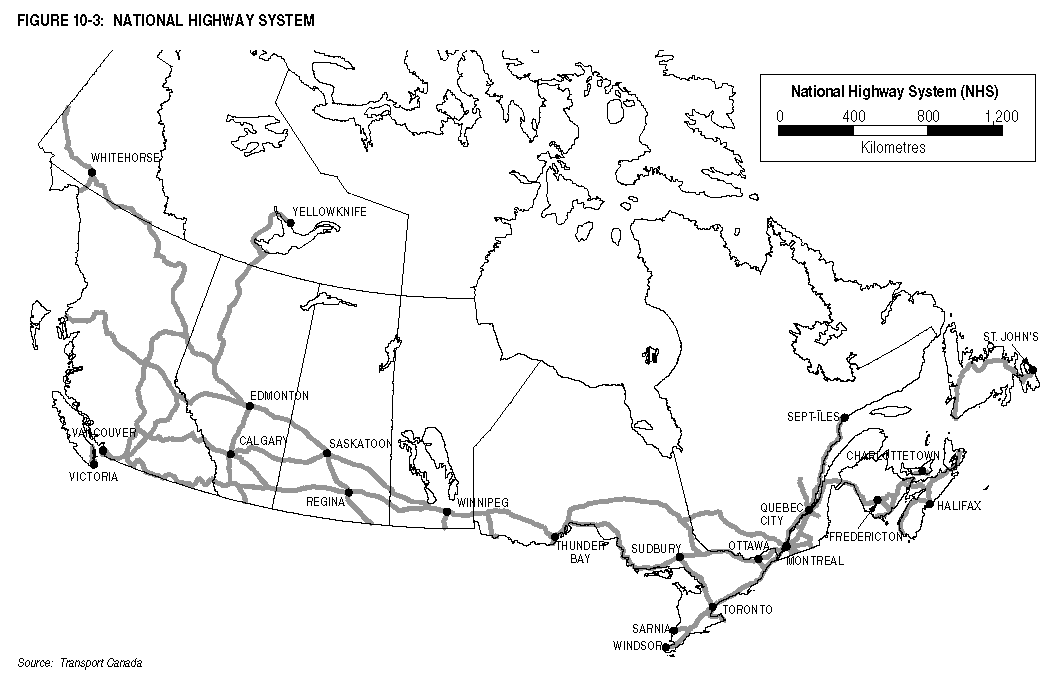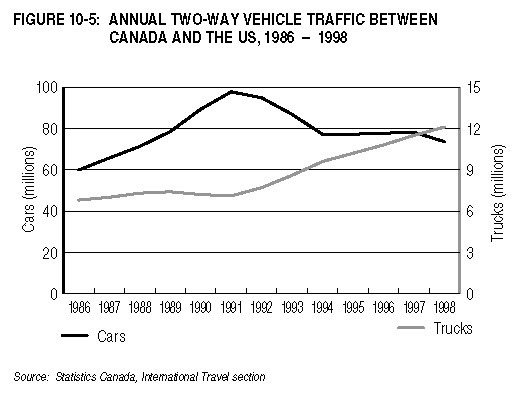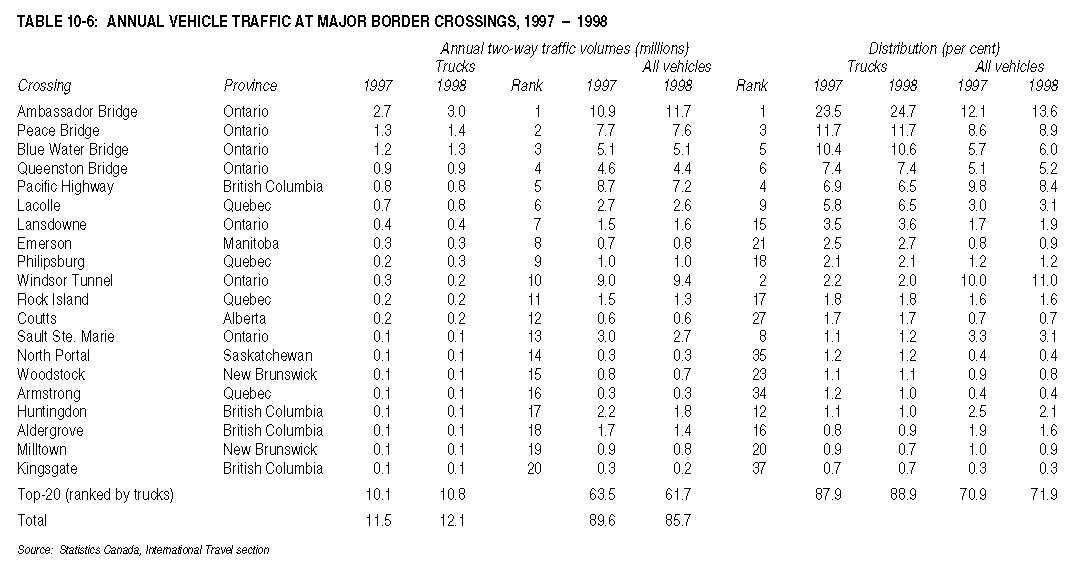10
TRANSPORTATION INFRASTRUCTURE
Road Transportation Infrastructure
The 1997 and 1998 Transport Canada annual reports presented
a breakdown by province and territory of the over 900,000 kilometres
of Canadian roads and highways. Because it was not possible to
obtain more recent information on the overall road system for
this year, this report's emphasis is on the National Highway System
(NHS) and traffic levels.
National Highway System
The National Highway System is a network of roads identified
by the Council of Ministers Responsible for Transportation and
Highway Safety during a multi-stage policy study launched in September
1987. The goals of this study were to identify future needs
and define standards for a Canadian primary highway system of
national significance; establish the benefits and costs of meeting
these needs; and establish the necessary funding arrangements
between governments.
A number of criteria were used to select highways for inclusion
in the National Highway System. The highways had to be existing
primary routes that provide interprovincial and international
trade and travel by connecting (as directly as possible) a capital
city or major provincial population or commercial centre in Canada
with:
- another capital city or major population centre;
- a major point of entry or exit to the US highway network;
or
- another transportation mode served directly by the highway
mode.
This defined principal highway network, which is illustrated
in Figure 10-3, is nearly 24,500 kilometres in length.

Traffic levels
The National Highway System is a small percentage of the
public road and street network in Canada. It is, however, heavily
used, accounting for nearly one quarter of the total vehicle-kilometres
driven. Table 10-5 illustrates vehicle traffic levels on the National
Highway System by province for the years 1986, 1993 and 1996.

Nearly 80 billion vehicle-kilometres were generated in 1996,
up almost nine per cent from 1993 and almost 40 per cent
from 1986. This equates to a 3.3 per cent average annual growth
rate in vehicle traffic for the period. In 1996, Ontario and Quebec
together accounted for over 60 per cent of the total vehicle-kilometres
on the National Highway System, with Ontario alone generating
36 per cent of the total and Quebec 25 per cent. These
were the only two provinces to have a vehicle-kilometres' share
greater than their share of the National Highway System network.
The next heaviest travelled province was British Columbia, which
generated 11 billion vehicle-kilometres in 1996, or 14 per cent
of the total. This in turn was followed by Alberta at 8.4 billion,
or nearly 11 per cent of the total travel. Saskatchewan represented
nearly four per cent of total travel, followed by Nova Scotia
with 3.4 per cent, New Brunswick with about three per cent, Manitoba
with nearly two per cent, and Newfoundland and Prince Edward Island
together with two per cent of the total.
In terms of annual average daily traffic (AADT), Ontario's
and Quebec's portions of the National Highway System were very
heavily travelled, averaging over 15,000 vehicles per day
in Ontario and over 18,000 vehicles per day in Quebec. The
next busiest on average was Nova Scotia, with over 8,000 vehicles
per day, followed by Alberta and New Brunswick each with 6,500 cars
and trucks per day. The remaining provinces each averaged less
than 6,000 vehicles per day on their particular sections of the
National Highway System.
Figure 10-4 illustrates how substantially vehicle traffic varies
by geographic location. Daily car and truck volumes are depicted
in two ways in this figure: traffic ranges and traffic bands.
In traffic ranges, a particular shade of gray is assigned to a
defined traffic interval (i.e. black represents road sections
having less than 5,000 vehicles per day). In traffic bands, line
thickness is proportional to the level of traffic passing over
a section of road.

Vehicle traffic is heavily concentrated around major urban
areas in Canada, especially Toronto, Montreal and Vancouver, and
is distributed heavily along a few highway corridors. The busiest
corridor in Canada is the Highway 401--Autoroute 20 corridor running
from Quebec City to Windsor. Traffic levels routinely average
over 30,000 vehicles per day and rise significantly in and
around Toronto and Montreal. Traffic through some sections of
Highway 40 in the Montreal core exceeds 150,000 vehicles
per day, while traffic on some sections of Highway 401 passing
through the Toronto area is more than twice as busy, exceeding
400,000 vehicles per day in some places.
The busiest corridor outside central Canada is a portion of
the Trans-Canada Highway in the lower mainland of British Columbia
running from Chilliwack to Vancouver. Traffic exceeds 50,000 vehicles
per day over many sections of this road and exceeds 120,000 per
day in the Greater Vancouver Area.
The next busiest corridor is Highway 2 running between Calgary
and Edmonton. Traffic levels average almost 15,000 vehicles per
day over this 300-kilometre stretch of highway. The most heavily
travelled corridor in Atlantic Canada is Highway 102 between Truro
and Halifax. Average daily traffic volumes exceed 15,000 vehicles
over most sections of this highway.
Traffic between Canada and the United States
Since the mid-1980s, vehicle traffic between Canada and the
US has been characterized by two distinct trends in car and truck
movements. As Figure 10-5 shows, car traffic grew strongly during
the late 1980s, peaking at 100 million two-way movements in 1991,
but has since declined, levelling off during the mid-1990s. Many
of these fluctuations can be attributed to variations in the value
of the Canadian dollar relative to the American dollar. During
the late 1980s, for example, substantial appreciation in the Canadian
dollar touched off unprecedented crossborder shopping activity
by Canadians, increasing the number of trips across the border
by over 60 per cent between 1986 and 1991.

With the onset of a serious recession during the early 1990s,
compounded by the depreciation of the Canadian dollar, car traffic
fell below 80 million movements a year and stabilized at approximately
77 million crossings during the mid-1990s. In 1998, car movements
fell appreciably for the first time since 1994 to 74 million
movements, approximately two million trips more than the 1988
level.
In contrast, truck traffic grew markedly during the 1990s.
Throughout the 1980s, truck movements were relatively stable at
about seven million two-way movements a year. Since the coming
into force of the Canada-US Free Trade Agreement in 1991
and the North American Free Trade Agreement in 1994, however,
truck volumes have surged, rising at an average annual rate of
nearly seven per cent to the current level of about 12 million
crossings each year.
Crossborder traffic is heavily concentrated among a small number
of sites. As Table 10-6 shows, from 1997 to 1998, almost 90 per
cent of total truck movements passed through 20 border-crossing
sites. For the same period, these 20 busiest crossings accounted
for over 70 per cent of total vehicle movements. Four of
the busiest truck crossings were located in Ontario: the Ambassador
Bridge in Windsor, the Peace Bridge in Fort Erie, the Blue Water
Bridge in Sarnia, and the Queenston Bridge in Niagara Falls. These
top four truck crossings alone handled 6.6 million trucks
in 1998, or 54 per cent of the total truck traffic. British Columbia
and Quebec each had four crossings in the top 20, with their busiest
crossings, Pacific Highway and Lacolle, respectively, rounding
out the top six crossings. New Brunswick had two crossings in
the top 20, while the Prairie Provinces each had one.

Road Transportation Infrastructure
- Appendix 10-1 Personal Expenditures
on Transportation, 1998
|

